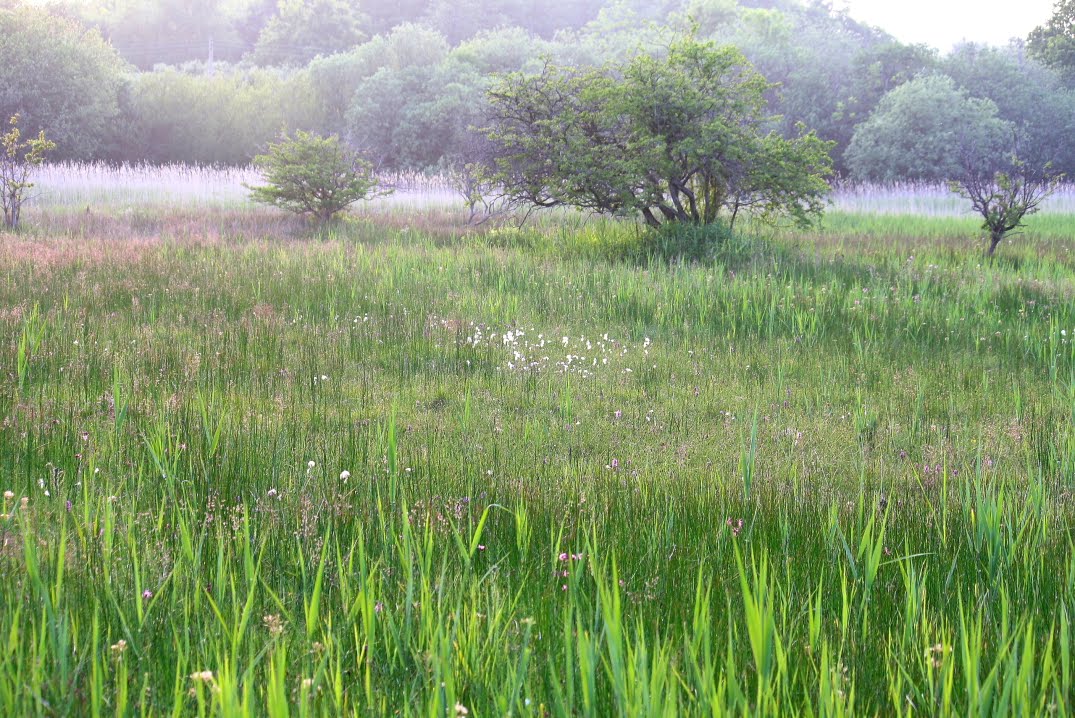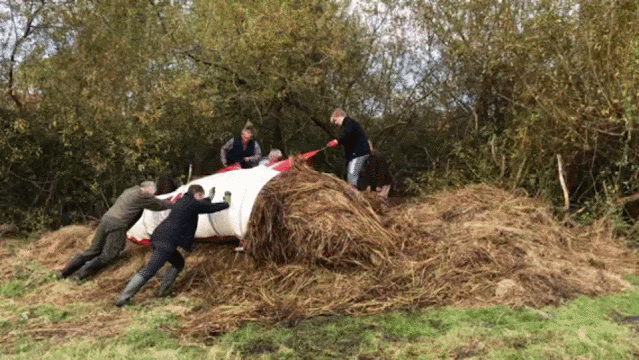It might only be temporary, but the media are at last showing real interest in the conjoined climate and biodiversity crises, such that coverage is everywhere. Encouraged no doubt by the impending COP26 conference, and Prince William’s Earthshot prize awards, no-one in Britain can now be unaware of these issues. I only hope the focus stays on them once the media circus moves on. For my part, I take some comfort from knowing that my volunteering on our commons is making a small contribution. We know that peaty wet places have an even greater effect on removing carbon from the atmosphere than trees, so our efforts to keep our little patch in good order have real value. Having completed our scheduled work on the central fen area, we’re still currently working on the species-rich wet grassy areas alongside Warren Road. A major part of the task is to keep at bay the encroaching willow and alder trees – which if left unchecked would overwhelm the areas, and in drying them out actually release the carbon they’ve been busy storing. We’ve been splashing about in a lot of water there lately, and it occurs to me that the Common also acts as a great big sponge, probably preventing flooding in the area. Alongside all that of course, maintaining them helps to protect the many special plants growing there, and the myriad small (and largely un-surveyed) creatures depending on them, so in turning out at the weekend to do my bit, I’m ticking several boxes at once; that’s presumably what economists like to call productivity.
One of the many causes of biodiversity loss is
out-competition by invasive non-native species, which with human help have
managed to escape from the predators that had evolved alongside them in their
far-away native homes. Over many years we have been pretty successful at
controlling the spread of Himalayan Balsam, which can so devastate wet areas.
There are many places nearby where this pernicious pest is not controlled, and
the way it dominates those places serves as a warning to us to keep up our
efforts. Very sadly, we have been powerless to control the spread of New
Zealand Pigmyweed Crassula helmsii which first afflicted us on Scouts’
Pond (off the Jubilee Boardwalk), but has now spread to The Pit. Himalayan
Balsam will have entered the wild having escaped from gardens; it’s all too
easy for it, with its method of ‘exploding’ seeds into flowing water, enabling
it to spread quickly along the watercourses it goes on to infest. Crassula
was sold as a garden pond plant, and it’s easy to see how that got out. This
wretched plant is easily transported from place to place on the fur or feathers
of wildlife or pets, or the boots of people. Effective options for its removal
are limited and expensive, so this is a problem that NWT may struggle to
resolve. In the meantime, it is incumbent on us all to ensure our own pets
don’t add to the problem, by keeping them out of the ponds.
Now that the opportunity has arisen to cut back the
vegetation around the Pit, the extent of the infestation is horribly clear for
all to see. Team Leader Julie reports: “Kevin ran a small work party on the
Sunday following our last main work party, clearing the overgrown brambles,
reed and shrubs to restore the three viewpoints into the pit. We also cut back
the tree and shrub growth encroaching onto Pit Common. The reed in the Pit was
also strimmed to reduce the growth in the water.
The Crassula is a real problem in the Pit and we couldn’t
impact on that today but you can now see that there is water in the area. We
all had to wash our equipment and boots when we came out of the water to
prevent cross contamination from the Crassula.”
During the session...
And after the session.
Boot cleaning at the end…. Kevin clearly knows his place!!
Bailey managed to get a picture of a vole we saw by the Pit.
Here is Team Leader Kevin’s message of thanks:
Thank you very much to the
restricted group of volunteers who came to Pit Common this morning. We have
achieved an awful lot: cutting and removing weeds, brambles and nettles. Some
of the trees were given a gentle trim as well. Opening up the viewpoints from
the benches works really well.
We welcomed our new student
volunteer. Thank you to Bailey for all his hard work. We look forward to seeing
him at future work parties.
Regards, Kevin
As with the fens further down the road, the Pit must be providing a free service to the village in holding at least some of the water rushing down Pit Street in times of flood.
… and the same view in July 2021
And so to Sunday’s main event – completing the clearing of
previously cut vegetation from Area A. A fortnight ago, the vote was put to the
assembled company on whether now the equinox had passed we should revert to
starting our sessions at 10.00 am. The cheers following that momentous act of
democracy must have echoed round the village for some time, so two weeks on 22 bright-eyed and well-rested volunteers convened on the area bordering Warren
Road. We were blessed with ideal weather for the job this time: not too hot,
not too cold, with a bit of sunshine to keep us cheerful, and absolutely no
precipitation, not of any kind. The windrows (or ricketts) were unsurprisingly
undisturbed, so the task at hand was to transfer them to the four drag sheets
as efficiently as possible, wet and heavy as they were.
A couple of windrows were close enough to the edge of the Alder carr for a group of highly motivated pitchfork wielders to transfer the stuff direct.
One of the challenges is the tipping over of the loaded
sheet at the dumping point. Before we had the winch to help us, this was by far
the most tiring part of the whole process, but even now a bit of manual
intervention is sometimes called for.
The result is of course a growing heap, which initially at first
assumes huge proportions…
.. but it does rot down and disappear remarkably quickly.
After an hour’s hard labour, the refreshment break was as
welcome as ever.
We were struck by the layout of the abandoned pitchforks,
most bearing their users’ gloves.
With so many people there we got the work done extremely well, and would probably have finished well within the scheduled two hours, if it had not been for The Twist. Unlike its worn-out predecessor, our new rope is determined to constantly twist itself whilst in use. Now a twisted rope makes winching impossible, as the convoluted loops it puts itself in will jam the drum on the winch – and that might mean we need another rope, or worse still, another winch. So the winch team found they had to painstakingly un-twist the wretched thing between each pull, greatly slowing down the normally very smooth operation, and causing them to work overtime (at double the usual rate of course!)
Here is how the area looked at that point:
The boardwalk edge between the car park and our storage container was also trimmed back.
Also previously cut stuff from along the boardwalk…
...was moved to a dump site further into the woody area...
...leaving the site looking much nicer.
Here is Team Leader Julie’s Message of thanks:
Dear volunteers
A huge thank you goes out to
the team of volunteers who turned out this morning to finish the clearance of
the cut reed on Area A. Due to the need to cut it before the end of September
(to satisfy Natural England) this reed had been sat for several weeks and had
become quite heavy to move. Most of it was moved onto the sheets for winching
to the dump sites, but mention must be made to the small group who manually
moved the reed near the bottom of the area onto a separate heap.
The winching operation was
hampered today by issues with our new rope getting twisted. So special thanks
also to those who ended up staying almost an extra hour to complete the dumping
and painstakingly untwist the length of the rope at the end of the session.
Away from the main group we
had people clearing cut scrub from the boardwalk edges to a dump site further
back into the scrub and a lonely pair over the other side of the boardwalk
clearing the boardwalk edges along to the car park. The entire boardwalk on the
SSSI common is now passable with ease, so thank you to those who have worked at
this over the weeks.
There were a lot of people
using the boardwalk this morning and enjoying the common, which was lovely to
see.
We cannot begin cutting the
areas of 'reed bed' until December so our outing in two weeks time will most
likely be at School Common, but we will confirm this a few days before the work
party.
Thanks for all your hard work
and support - it is very much appreciated.
Regards, Julie (for the Team Leaders)


































